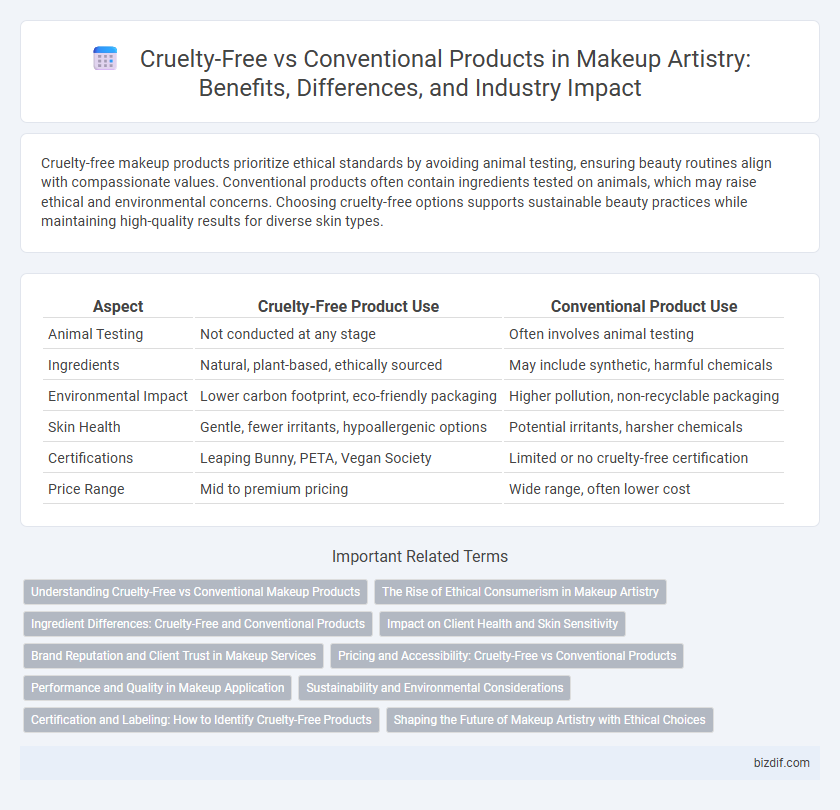Cruelty-free makeup products prioritize ethical standards by avoiding animal testing, ensuring beauty routines align with compassionate values. Conventional products often contain ingredients tested on animals, which may raise ethical and environmental concerns. Choosing cruelty-free options supports sustainable beauty practices while maintaining high-quality results for diverse skin types.
Table of Comparison
| Aspect | Cruelty-Free Product Use | Conventional Product Use |
|---|---|---|
| Animal Testing | Not conducted at any stage | Often involves animal testing |
| Ingredients | Natural, plant-based, ethically sourced | May include synthetic, harmful chemicals |
| Environmental Impact | Lower carbon footprint, eco-friendly packaging | Higher pollution, non-recyclable packaging |
| Skin Health | Gentle, fewer irritants, hypoallergenic options | Potential irritants, harsher chemicals |
| Certifications | Leaping Bunny, PETA, Vegan Society | Limited or no cruelty-free certification |
| Price Range | Mid to premium pricing | Wide range, often lower cost |
Understanding Cruelty-Free vs Conventional Makeup Products
Cruelty-free makeup products are formulated and tested without harming animals, often certified by organizations like Leaping Bunny or PETA, ensuring ethical beauty choices. Conventional makeup products may involve animal testing at various stages, which raises concerns about animal welfare and environmental impact. Understanding these differences helps consumers make informed decisions based on ethical standards and the safety of ingredients used in their makeup routine.
The Rise of Ethical Consumerism in Makeup Artistry
Cruelty-free makeup products have surged in popularity as consumers increasingly prioritize ethical sourcing, animal welfare, and environmentally sustainable practices over traditional cosmetics that often involve animal testing and harmful chemicals. This shift reflects a broader trend in makeup artistry where professional artists and brands adopt cruelty-free lines to meet the demand for transparency and social responsibility. Market analysis reveals that cruelty-free cosmetics now represent a significant and growing segment, driving innovation and reshaping industry standards toward more conscious consumerism.
Ingredient Differences: Cruelty-Free and Conventional Products
Cruelty-free makeup products prioritize ethically sourced, plant-based ingredients, avoiding animal testing and harsh chemicals like parabens, sulfates, and synthetic dyes commonly found in conventional products. Ingredients such as natural oils, botanical extracts, and mineral pigments characterize cruelty-free formulations, promoting skin health and environmental sustainability. Conventional makeup often contains synthetic preservatives, petrochemicals, and allergens, which may increase the risk of skin irritation and ecological harm.
Impact on Client Health and Skin Sensitivity
Cruelty-free makeup products typically contain fewer irritating ingredients and avoid harsh chemicals commonly found in conventional products, significantly reducing the risk of allergic reactions and skin sensitivity in clients. Many cruelty-free brands prioritize natural and hypoallergenic formulations, enhancing skin health by minimizing exposure to toxins and synthetic additives. Using cruelty-free products supports safer, more gentle makeup applications, improving overall client satisfaction and long-term skin wellness.
Brand Reputation and Client Trust in Makeup Services
Using cruelty-free makeup products enhances brand reputation by aligning with ethical values, appealing to socially conscious clients, and demonstrating corporate responsibility. Conventional product use may undermine client trust due to growing consumer awareness of animal testing practices and ethical considerations. Prioritizing cruelty-free options fosters client loyalty, positive reviews, and a competitive edge in the makeup artistry industry.
Pricing and Accessibility: Cruelty-Free vs Conventional Products
Cruelty-free makeup products generally command higher prices due to ethical sourcing, specialized testing methods, and smaller scale production compared to conventional products, which benefit from mass manufacturing and broader distribution. Accessibility of cruelty-free brands remains limited in mainstream retail, often requiring online purchases or specialty stores, whereas conventional products are widely available in drugstores and supermarkets worldwide. Consumers prioritizing ethical beauty face a trade-off between paying premium prices and navigating limited availability versus choosing affordable, easily accessible conventional options.
Performance and Quality in Makeup Application
Cruelty-free makeup products often rival conventional counterparts in performance and quality, offering vibrant pigmentation, long-lasting wear, and smooth application through ethically sourced ingredients. Innovations in formulation have minimized compromises on texture, blendability, and finish, ensuring professional-level results without animal testing. Some conventional products may use synthetic chemicals for enhanced durability, but many cruelty-free brands now achieve comparable effects using natural, sustainable alternatives.
Sustainability and Environmental Considerations
Cruelty-free makeup products prioritize sustainability by avoiding animal testing and often incorporate biodegradable ingredients and eco-friendly packaging, reducing environmental impact compared to conventional products. Conventional makeup typically relies on synthetic chemicals and petroleum-based components that contribute to pollution and resource depletion. Choosing cruelty-free brands supports ethical sourcing and promotes biodiversity conservation, aligning with global efforts to minimize ecological footprints in the beauty industry.
Certification and Labeling: How to Identify Cruelty-Free Products
Certifications like Leaping Bunny, PETA's Beauty Without Bunnies, and Choose Cruelty-Free provide reliable indicators for identifying cruelty-free makeup products. Look for these labels on packaging, which signify that the brand prohibits animal testing throughout product development. Understanding these certifications helps consumers make informed, ethical choices between cruelty-free and conventional makeup brands.
Shaping the Future of Makeup Artistry with Ethical Choices
Cruelty-free product use in makeup artistry emphasizes commitment to ethical standards by avoiding animal testing and promoting sustainable ingredients, which aligns with growing consumer demand for transparency and responsibility. Conventional product use often relies on established formulas that may involve animal testing and environmentally harmful practices, risking reputational impact as the industry shifts towards ethical innovation. Prioritizing cruelty-free options shapes the future of makeup artistry by fostering inclusivity, advancing eco-conscious formulation, and enhancing brand loyalty in a competitive, socially aware marketplace.
Cruelty-Free Product Use vs Conventional Product Use Infographic

 bizdif.com
bizdif.com